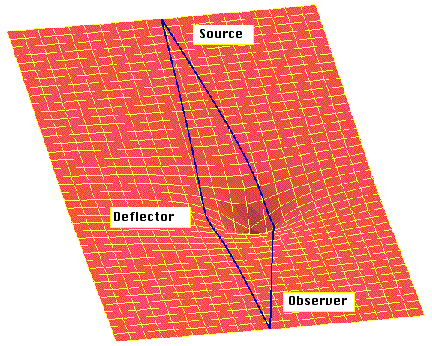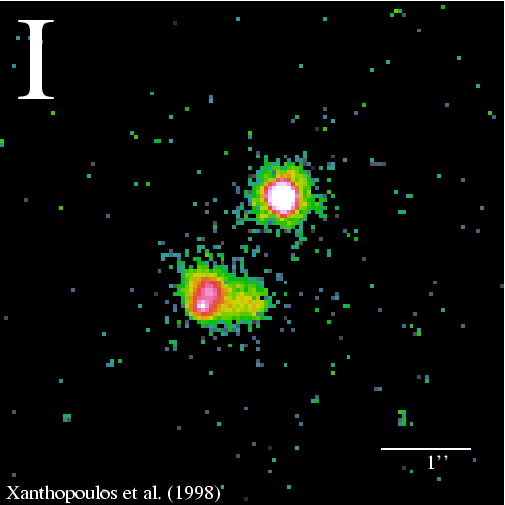




That is, it's '11 light-years away', where ONE light-year, the *distance* light travels in a year at its fixed speed of 186,000 miles per second, works out to about 5.9 TRILLION miles. And so this ancient galaxy is 5.9 trillion x 11 billion miles away. So if you plan on visiting, pack a few extra sandwiches.





For many of the cases of interest one does not need to fully solve the general relativistic equations of motion for the coupled spacetime and matter, because the bending of spacetime by matter is small. (Quantitatively the matter bending space is moving slowly relative to c, the speed of light and the "gravitational potential" Phi induced by the matter obeys |Phi|/c2 << 1 .)
A sketch of the paradigm of a lensed system is below ( source): 
In a system where lensing occurs there is a
The most extreme bending of light is when the lens is very massive and the source is close enough to it: in this case light can take different paths to the observer and more than one image of the source will appear.  A multiple image is shown at right (source). The first example of a double image was found in 1979, of a quasar. The number of lenses discovered has been used to estimate the volume of space back to the sources. This volume depends strongly on cosmological parameters, in particular the cosmological constant (a classic reference is here).
A multiple image is shown at right (source). The first example of a double image was found in 1979, of a quasar. The number of lenses discovered has been used to estimate the volume of space back to the sources. This volume depends strongly on cosmological parameters, in particular the cosmological constant (a classic reference is here).
If the source varies with time, the multiple images will vary with time as well. However, the light doesn't travel the same distance to each image, due to the bending of space. So there will be time delays for the changes in the images. These time delays can be used to calculate the hubble constant H0. A few systems with these time delays have been found and are under study. Much of the subtlety in this work lies with constructing the model of the mass distribution forming the lens (see this review for technical detail).
In some special cases the alignment of the source and the lens will be such that light will be deflected to the observer in an "Einstein ring." Some examples and references can be found here on Wikipedia. More often than a ring, the source may get stretched out and curved, and form a tangential or radial arc. A lot of mass is needed to cause an arc to appear, so that properties of arcs (numbers, size, geometry) can often be used to study massive objects like clusters. One can also, given a set of images, try to reconstruct the lens mass distribution (for an example of reconstructing a cluster as a lens see this technical paper).
In many cases the lens is not strong enough to form multiple images or arcs. However, the source can still be distorted: both stretched (shear) and magnified (convergence). If all sources were well known in size and shape, one could just use the shear and convergence to deduce the properties of the lens. However, usually one does not know the intrinsic properties of the sources, but has information about the average properties.
The statistics of the sources can then be used to get information about the lens. For instance, galaxies in general aren't perfectly spherical, but if one has a collection of galaxies one doesn't expect them all to be lined up. Thus, if this set of galaxies is lensed, on average, or statistically, there will be some overall shear and/or convergence imposed on the distribution, which will give information about the intervening lens(es).
There is a distribution of galaxies far enough away that can be treated as sources, and thus clusters nearby can be "weighed" (i.e. have their mass measured) using their lensing. Superclusters have been considered as well. In addition, theories of cosmology predict the distribution of large scale structure, the distribution of matter in the universe.
The statistical properties of the large scale structure (e.g. the probability of finding a galaxy at one place when there is another a certain distance away) can also be measured by weak lensing, because the matter will produce shear and convergence in distant sources (which can be galaxies, or the cosmic microwave background, for example). Weak lensing is a useful complement to measures of the distribution of luminous mass such as galaxy surveys. Lensing measures all the mass, in particular the dark matter as well as the luminous matter.
In some cases the lensing is of an image that is so small or faint that one doesn't see the multiple images-- the additional light bent towards the observer just means that the source appears brighter. (The surface brightness remains unchanged but as more images of the object appear the object appears bigger and hence brighter.) This lensing can have effects in many measurements, as sources which would have otherwise been too dim become visible. This can be helpful, as when one wants to view objects that would otherwise be too far away. It can also be a problem, for example when one is trying to measure all objects brighter than a certain amount in a certain region and lensing introduces objects by magnifying objects enough to bring them into the sample.
There are ongoing searches to use lensing to find a type of dark matter called MACHOs (massive compact halo objects). Although MACHOs, as dark matter, cannot be seen themselves, if they pass in front of a source (e.g. a star nearby), they can cause the star to become brighter for a while, e.g. days or weeks. This effect has been observed, but determinations of the dark matter are not yet conclusive. Observations are underway by many groups. See these notes by Michael Richmond on Gravitational Microlensing: Searches and Results.
Incredible 2-hr NOVA documentary here on our own Milky Way Galaxy.
Inside the Milky Way - Full Documentary, 720p
(actually 1hr, 36min, since there are no commercials in this apparent DVD rip upload)
https://www.youtube.com/watch?v=ttz4Sr0tZFg
Astro Ping...
It’s nice to know we’re not at the edge, where if we went over we would end up on the other side...
“The newly discovered galaxy, known as A1689B11...”
All of this cosmological discovery is fine but I still think we need to go back to the moon ASAP. I think we could do it in five years or less. However, all of the ‘countdown clocks’ on TV and the internet would have to be reset from time to time. MAGA!
Awesome
Next thing you know, and you've got a spiral galaxy swirling down the crapper.
Your math is not right.
It’s actually much farther away than that. You haven’t taken into account the expansion of the universe that’s been going on the whole time that its light has been traveling. It’s somewhere in the vicinity of two to three times that far away. It is was 11 billion ly away 11 billion years ago.
I suggest that if you intend to visit, book passage on a very, very fast vessel, so that time, as you experience it, will be much, much less than 11 billion years.
https://www.aps.org/publications/apsnews/201412/muon.cfm
As a practical matter, even if the vessel’s speed is constrained only by accelerations that humans can survive, it might take several lifetimes to complete the journey.
Here is video of the flight of the space probe.
Turns out there is a giant little girl in that galaxy.
https://www.youtube.com/watch?v=EWwhQB3TKXA
That’s how far away it was 11 billion years ago.